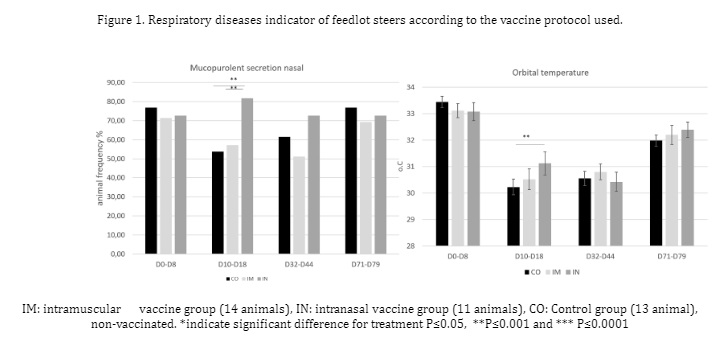Intranasal and intramuscular commercial vaccines against respiratory viruses in steers finished in feedlot
DOI:
https://doi.org/10.21708/avb.2023.17.4.12066Resumo
Bovine respiratory disease (BRD) is a condition of high incidence, especially in feedlot cattle, however, there is still no consensus on the most effective vaccine protocol for its control. The objective was to evaluate two vaccine protocols against BRD in steers finished in feedlot and their influence on respiratory indicators and weight gains. This study included 42 ½ Angus blood steers, distributed in control, IN, and IM groups. On the IN protocol, the steers received a single vaccine dose on the day of the feedlot entrance. For the IM protocol, they received two vaccine doses, the primo vaccination was performed 21 days prior to the feedlot and the reinforcement on the day of feedlot entrance. BRD indicators, body weight gain, and serum levels of immunoglobulin-G, immunoglobulin-A, and haptoglobin were measured. At slaughter, the presence and severity of pneumonia were analyzed. IM protocol presented a lower BRD indicators and incidence of pneumonia (P=0.0004 CO and P=0.03, IN) and better performance (body weight gain and slaughter weight (P=0.05) than the other groups. IN presented more respiratory disease indicators from on D7 and the same performance of the control group. We conclude the IM protocol was more effective for steers finished in feedlot.
Downloads

Downloads
Publicado
Edição
Seção
Licença
Copyright (c) 2024 Acta Veterinaria Brasilica

Este trabalho está licenciado sob uma licença Creative Commons Attribution 4.0 International License.
Autores que publicam na Acta Veterinaria Brasilica concordam com os seguintes termos: a) Autores mantém os direitos autorais e concedem à revista o direito de primeira publicação, com o trabalho simultaneamente licenciado sob a Licença Creative Commons Attribution que permite o compartilhamento do trabalho com reconhecimento da autoria e publicação inicial nesta revista. b) Autores têm autorização para assumir contratos adicionais separadamente, para distribuição não-exclusiva da versão do trabalho publicada nesta revista (ex.: publicar em repositório institucional ou como capítulo de livro), com reconhecimento de autoria e publicação inicial nesta revista. c) Autores têm permissão e são estimulados a publicar e distribuir seu trabalho online (ex.: em repositórios institucionais ou na sua página pessoal) a qualquer ponto antes ou durante o processo editorial, já que isso pode gerar alterações produtivas, bem como aumentar o impacto e a citação do trabalho publicado (Veja O Efeito do Acesso Livre).


 Esta obra está licenciada com uma Licença
Esta obra está licenciada com uma Licença 